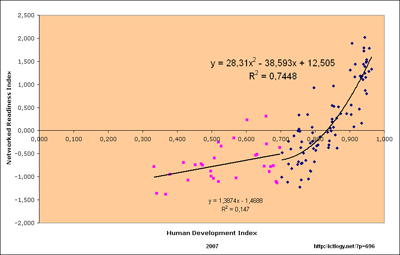Two years ago we here spoke about e-Readiness and the Human Development Index. The chart we then plotted was similar to this one:
This chart now adds two tendency curves: one (exponential) for countries with a Human Development Index (HDI) over 7.00, and another one (linear, though absolutely irrelevant, on the other hand) for countries under 7.00 — though there are lots of countries missing: too poor to appear on the charts…).
Even if the regression is not really accurate (not at all) we can more or less see a relationship between e-Readiness and Development (as measured as HDI).
One of the main criticisms I have against how the digital divide, the Information Society or e-Readiness is measured (see below “More info” for a couple of references) is that it either takes one of the following paths:
- Focus almost exclusive on infrastructures
- A too broad approach thus including “analogue noise” (i.e. non-digital indicators or analogue economy indicators — provided such a thing makes sense, which I believe it does in the field of development)
In any case, huge voids appear: digital literacy levels, the regulation framework and richness of content and e-services.
Are these lacks relevant?
Let’s take a look at the measurement of Inequality (from the HDI database, calculated after the World Bank’s World Development Indicators), comparing the ratio of 20% richest ones to 20% poorest ones, and ratio of 10% richest ones to 10% poorest ones. And we chart it against the year 2007 World Economic Forum’s Networked Readiness Index (we plot the second one logarithmically, just for a change):
As can be easily seen in both comparisons — linear for the 20% to 20% inequality; logarithmically for the 10% to 10% inequality — there does not seem to be any kind of relationship between e-Readiness and Inequality. But whose problem is this? the reality’s or our models’? Does it really make sense that a country with highest inequalities can be as e-ready as another one with a more balanced income/wealth distribution?
It is no news that income inequalities carry on associated inequalities in education, in political stability, social and community engagement, security and crime, etc. So, can a society with low/uneven human capital, political instability, poor community engagement, high crime rates… be as e-ready as another one with better scores in these indicators? Intuition clearly and loudly shouts no, not at all, by any means.
Then, where’s the problem? In my opinion, it undoubtedly is in how we measure how good our degree of Information Society development is.
And, if so, where are we failing? I guess here are some places to look at:
- We pay too much attention to infrastructures. They are needed, of course, but they are means, not ends. ICT infrastructures should be seen as a necessary condition for ICT development, but not as a sufficient condition.
- We quite always forget about digital literacy, getting rid of it with a simple “number of Internet/PC/mobile phone users” indicator, an indicator which does not measure how different uses can leverage ICTs for development.
- Even if we approach digital literacy, aggregate measures do not discriminate between different users and the individual benefits they get, or how their different levels of skills impact on their productivity or their employability.
- At the aggregate level, it is easy that big firms’ ICT achievements and Governments’ big investments overshadow poor ICT adoption and performance by SMEs, thus provoking a paradox: at the aggregate level, ICT investment and consumption is great, but “no one” is using them (a reframing of Solow paradox?).
- Our knowledge on how ICTs affect social parameters — out of the Economy arena — is way too poor. So, we are having tough times to incorporate such parameters in our e-Readiness models and indices. Does e-Administration, e-Government and e-Democracy matter? At what level? Does ICT skills matter in multi-factor productivity? At what level? Can this be included in our models?
Put short: I guess we are missing people in our models. I am not saying it is easy to do, but we are actually missing the key.
More info
- Peña-López, I. (2007). ICTs for development: from e-Readiness to e-Awareness. Seminar imparted in Barcelona, November 20th, 2007 at the Executive Master in e-Governance, École Polytechnique Fédérale de Lausanne. Barcelona: ICTlogy.
- Peña-López, I. (2007). Unpeeling the layers of the digital divide: category thresholds and relationships within composite indices. ICTlogy Working Paper Series #2. Karlstad: ICTlogy.
